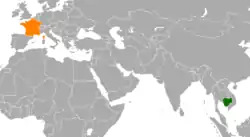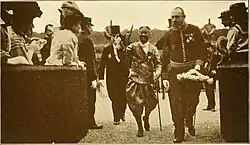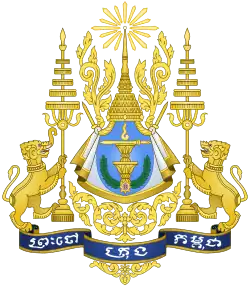 | |
Cambodia |
France |
|---|---|
Cambodia–France relations (Khmer: ទំនាក់ទំនងកម្ពុជា–បារាំង, French: Relations Cambodge–France) are the bilateral relations between the Kingdom of Cambodia and the French Republic. Cambodia was a protectorate of France from 11 August 1863 to 9 November 1953. King Norodom approached the French in 1861, in an attempt to stop neighbors Thailand and Vietnam from swallowing Cambodia's land.
History

A treaty was signed in 1863 by King Norodom and was approved by his counterpart Napoleon III. Cambodia officially became a protectorate of the French empire on 11 August 1863.[1] Cambodia gained its independence in November 1953, thanks to Prince Norodom Sihanouk.[2]
France and Cambodia enjoy close relations, stemming partly from the days of the French Protectorate and partly from the role played by France in the signing of the peace agreements in Paris in 1991,[3] and further cemented by the French language. These relations are gradually adapting to Cambodia's growing integration into its regional environment and its progress towards the status of a Middle Income Country, hopefully by 2020. The "Orientation and Cooperation Document" signed in 2010, steers our cooperation towards the following goal: "supporting economic growth and job creation in Cambodia by developing human capital and promoting French private investment".[4]
French president Charles de Gaulle visited Cambodia in 1966 and was given a warm welcome by Prince Norodom Sihanouk.[5]
French assistance

France was part of the United Nations Transitional Authority in Cambodia.
Migration
France has one of the largest Cambodian diaspora communities outside the United States, largely because of the refugees who fled Cambodia who escaped the Khmer Rouge in the 1970s.[6] As of 2015, there are around 80,000 Cambodians living in France.[7] A Cambodian restaurant Le Petit Cambodge was among the sites of the November 2015 Paris attacks, though it is unclear whether any Cambodians were among those killed.[8]
Resident diplomatic missions
- Cambodia has an embassy in Paris.
- France has an embassy in Phnom Penh.
See also
Notes and references
- ↑ Forest, Alain (1 March 1993). "Chapter 1: Les années d'impuissance coloniale". Le Cambodge et la colonisation française [Histoire d'une colonisation sans heurts (1897 - 1920)] (in French). Editions L'Harmattan. pp. 6–12. ISBN 9782858021390.
- ↑ Sihanouk, Norodom; Lacouture, Jean (1972). L'Indochine vue de Pékin [Entretiens] (in French). Éditions du Seuil. p. 53.
- ↑ Levy, Tali; Greenberg, Melanie; Barton, John H.; McGuinness, Margaret E. (1 December 1999). "The 1991 Cambodia Settlements Agreements". Words over War [Mediation and Arbitration to Prevent Deadly Conflict]. Rowman & Littlefield. pp. 139–142. ISBN 978-0847698929.
- ↑ www.diplomatie.gouv.fr http://www.diplomatie.gouv.fr/en/country-files/cambodia-485/france-and-cambodia/political-relations-6764/. Retrieved 3 March 2014.
{{cite web}}: Missing or empty|title=(help) - ↑ Pantheon-Sorbonne University (ed.). "La visite du général de Gaulle à Phnom Penh. Entre mythes et réalités". Archived from the original on 2014-10-06.
- ↑ "In Phnom Penh, Cambodia, the French influence lives on - The Washington Post". The Washington Post.
- ↑ Danaparamita, Aria (21 November 2015). "Solidarité". The Cambodia Daily. Archived from the original on 20 June 2019. Retrieved 19 June 2019.
- ↑ "In Paris, a Cambodian Restaurant Caught in the Attack". VOA Cambodia. 17 November 2015.
